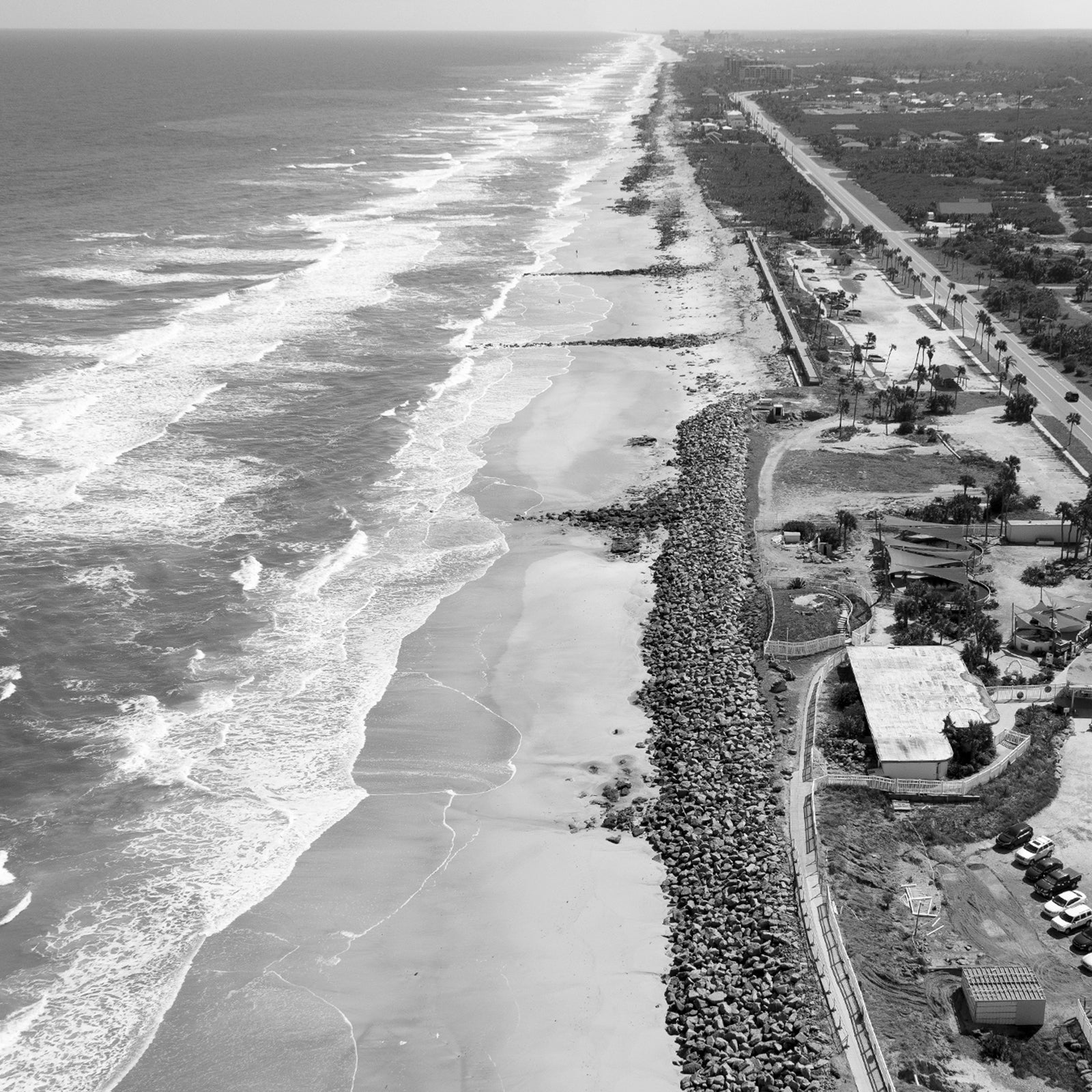If you ask the average person in the U.S. about global warming, you’ll learn a lot about how they were raised, who they trust, and how they vote. It’s tempting to think of climate change as a cultural issue rather than, say, a fiscal one. At times the conversation can feel abstract or otherworldly, as if driven more by personal feelings or beliefs than the actual, material concerns of the present moment.
As three books released this fall illustrate, anthropogenic climate change is, in fact, already a trillion-dollar category of economic activity. This has been well-documented by writers and activists like Naomi Klein and Bill McKibben, but bankers, builders, brokers, developers, oil-tank workers, Marine Corps colonels, insurers, and engineers also share in the consensus. To many in these professions, it is abundantly clear that the U.S. derived a century and a half of comfort and security from the assumption that fossil fuels did more good than harm and were available in infinite supply. It was fun. But now anyone who cherishes that comfort and security will have to adjust their plans and rethink how they work, invest, travel, or simply make a living.
In denying the reality of climate change, many commentators depict these adjustments as prohibitively expensive or a magnet for careless spending. Staying the course, however, can be even more wasteful. As Pulitzer Prize winner Gilbert Gaul observes in his probing new book ($28, Sarah Crichton), the ever more frequent hundred-year hurricanes of the past two decades have already cost taxpayers hundreds of billions of dollars. And perversely, these costs create a windfall for FEMA, the Army Corps of Engineers, and other agencies that help towns and cities recover from floods.
While these parties aren’t inherently corrupt, their work relies on a persistent cycle of building and rebuilding along the Gulf of Mexico and Atlantic Ocean. The government can’t help but enable this: after every major storm, politicians survey the abandoned neighborhoods and shredded boardwalks, vowing to bring beach communities back to full strength. Real estate interests nod in agreement—if a town can’t rebuild, then property values collapse—and government grants are handed out to reconstruct homes and replace the sand, with no guarantee that they’ll stay in place. A few years later, they’re washed away again, and the cycle repeats. “Instead of homeowners retreating out of harm’s way, they build back, often in the same dangerous locations,” Gaul writes. “Insurance money and federal aid fuel building booms. Speculators and developers bid up prices. Land rushes follow.”
Once federal resources are available, it can be hard to keep track of how they’re handed out. In places like Florida and Alabama, the government helps subsidize flood insurance that would be unaffordable on the open market. After Hurricane Sandy, calls to restore homes and businesses in New Jersey resulted in FEMA spending $204,000 on a hockey rink and $194,000 on a baseball field. In one case, relief money was spent on repairs for an apartment complex that was more than 50 miles from the ocean. Even the owners of second homes can qualify for public assistance, and filling out the applications, according to Gaul, has become “an industry unto itself.” And not only real estate: tourism, transportation, recreation, and hospitality all have an incentive to pretend the coasts aren’t disappearing and hit up the feds to reconstruct their beaches. Clearly, there’s a lesson about developing our coastlines to be learned from Gaul’s reporting, but it’s not one that everyone is ready to hear.
“If the Pentagon itself dreads a troubled, chaotic world like this, all the rest of us should be at least as alarmed.”
Jeremy Rifkin, a consultant and business professor at the University of Pennsylvania, paints a more cheerful picture in ($28, St. Martin’s Press). Noting trends in renewable energy in the European Union and China, where the solar industry is thriving, Rifkin foresees a world in which fossil fuels rapidly lose their competitive advantage over enterprises based on renewables. In the U.S., he sees this shift leading to a massive restructuring of the economy. He’s convinced that worker pension funds, worth $25.4 trillion, will soon pull their investments out of oil and gas, and that new technologies will make communication, logistics, construction, and agriculture more efficient, causing energy prices to fall even further. All of this, presumably, will lead to a “showdown” between solar and wind energies and the fossil-fuel industry, which Rifkin argues will take place within about ten years.
It’s a bold prediction, resting on peer-reviewed papers and plenty of straightforward arithmetic—right down to the amount the U.S. should invest in fossil-fuel-free infrastructure if it wants to stay competitive. Unfortunately, Rifkin relies on a lot of slippage between the conditional and future tense, and he doesn’t always distinguish between how he hopes things should go and what will actually happen. Somehow it’s taken as a given that Americans consistently follow their own best interests, including in the energy sector, and that no party has more influence than it should. “The thing to bear in mind is that the collapse of the fossil fuel civilization is inevitable, despite any efforts by the fossil fuel industries to forestall it,” Rifkin writes. “Market forces are far more powerful than whatever lobbying maneuvers the fossil fuel industry might entertain.”
If this optimism is justified, then we’d have to assume that oil and gas companies in 2018 on campaign contributions to U.S. senators and congressmen like Ted Cruz, Beto O’Rourke, Kevin Cramer, and John Barrasso, without expecting anything in return. I’d love to think Rifkin has assessed the fossil-fuel lobby fairly, but that is an awfully large sum to shake off—or to exclude from any discussion of “market forces,” as if lobbying were somehow separate from these companies’ plans for survival. I’ve never met a fossil-fuel lobbyist, but I assume they’re not messing around.
You know who else isn’t messing around? The Pentagon. Michael Klare, a defense correspondent for The Nation and an author of 17 books on geopolitics, has all the material he needs to write a military espionage thriller set in 2035. His newest book, ($30, Metropolitan Books), isn’t desperate to entertain, but it will fascinate anyone who wants to know how warming seas and scarce resources might affect the work of the armed forces. In one scenario, Klare describes a drought in the Middle East that causes a spike in food prices, forcing thousands of farm families to leave the countryside. In the cities, ethnic conflict intensifies into a civil war, threatening allies and catalyzing a migration crisis. At the very least, the U.S. military would have a humanitarian role to play, but perhaps relief operations are also needed at home, following a tropical storm in the Southeast, a flood in the Midwest, or a cholera outbreak in the Caribbean. The Arctic has become a busy place, too, as melting ice caps have made mineral extraction more profitable and contentious. Meanwhile, the military’s own bases must adapt to the effects of storm surges, wildfires, and unstable shorelines. All of these things are easy to imagine, of course, because . What comes next is even scarier. “If the Pentagon itself dreads a troubled, chaotic world like this—even if solely out of its own institutional concern about military ‘overstretch’—all the rest of us should be at least as alarmed,” Klare writes.
Preparing for these scenarios is expensive—but not as expensive as ignoring them. After a hurricane, it could cost $5 billion to reconstruct an Air Force base or over $300 million to replace a single F-22 Raptor aircraft. Again, these sound like figures that Jack Ryan might rattle off to the president, but they are 100 percent nonfiction. And while some military sources use opaque language or jargon to describe the costs of doing nothing, Klare finds people who lay them out quite clearly. In the best passage in the book, he describes the unfailingly polite admiral Sam Locklear, commander of the U.S. Pacific Command, speaking to senator Jim Inhofe, a Republican from Oklahoma and an outspoken opponent of climate regulation, during a meeting of the Armed Services Committee on Capitol Hill. When Inhofe pushes Locklear to voice doubts about climate change and endorse the full-scale exploitation of America’s domestic energy supplies, the admiral stays silent. It’s awkward and grating to see Inhofe try and put words into the admiral’s mouth, but after several attempts, he quits and changes the subject.
The entire exchange lasts a minute or two. Maybe, if there were space in the committee’s schedule, Locklear would have made a more earnest attempt to convert a man who . But like most people, he was simply too preoccupied with his obligations here on earth. These obligations are serious and urgent and leave little time to wrestle with another adult’s concept of self-sufficiency, individual merit, or the “wise use” of natural resources. By talking the way he does about global warming, Inhofe may present himself as a shrewd and worldly operator, rather than someone whose feelings and beliefs have begun to collide, more and more, with how much things actually cost. But for the rest of us: those costs are real, and they are already immense. Frankly, Inhofe’s feelings don’t matter.


